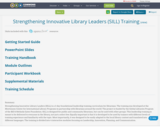
There are nine primary characteristics of what are considered the best library training programs. No one program fits every organization, but most training programs that are sucessful and show employees returning from them with marketable skills will have at least some of these qualities contained in them.1. Effective Management of the Training ProgramThe best programs will start with an individual who is the motivator behind the group. Irregardless of the title they hold, this is the person who organizes all the training sessions. The Training Librarian would be responsible for planning and executing all training innitiatives within the library system. the best person for the role would be someone who is innately curious, motivated, and have a vested interest in developing others' skills and to help them reach their potential within the library community. They must be committed to learning and want to help improve everyones skills, not just their own.In addition, the Training Librarian would have to market the program both internally and externally in order to make certain that people are aware of the opportunities that are available to them.2. Needs AssessmentThe Training Librarian would have to, periodically, perform an assessment of the organizational needs of both the employees and patrons/clients. Curiosity comes into play here. The Librarian must be interested enough in the past, present, AND future direction of the program to conduct a proper needs assessment through interviews, surveys, and research.Central to any training program is properly identifying the trining needs of each member of the community and on what topic(s). It is also imperative to remember that a "training need" is the gap between required performance and current performance.3. AlignmentOnce the Training Librarian identifies needs, then they must build a curriculum to address those needs based on supporting the library goals. This way, employees will understand why the training is occuring and managers will support the activity. After all, every activity needs a purpose.4. GoalsWhen the Training Librarian develops Goals for the program, they must make sure to look at the entire picture, including quality, quantity, time, cost, and effectiveness. They must develope a method for testing the progress towards the orginazational goals and ensure reports are easily readable for the needed information. It is best to schedule time to monitor and review progress toward the goals on a regular basis.5. Leadership ApprovalLeadership must be willing to approve of the program from the top down. Having leadership backing the program will reenforce the importance of a program and improve accountability while also assisting to establish expectations. the Training Librarian must always be ready to talk about how the program impacts the financial side of the library program when presenting new ideas as this will impact leadership approval.6. RelevancyThe training librarian must provide training content that is applicable in order to guarantee that the learners will return for more. Catering content to their needs is vital. Catering content to employee and client needs is vital so they can walk away from teh training with something that may be immediately applied.7. CreativityA creative hook is often something that gathers peoples' attention and deemed more valuable to an organization. Creativity can start as small as a theme, go as big as a new "Brand" for the training, or even become a library mascot. The level of fun and familiarity with creative ploys will continue to pull people to the training sessions just to see what is next.8. MarketingMarketing does not stop at the innitial launch of a program. It continues through ongoing efforts throughout the program to make it successful and is integral to making the development of a traing program a success. Any communicattion that is relayed to employees or clients should include an overvieview of the program and clear expectations while showing the individuals what is in it for them. Always remember to provide a why behind every part of the training. The ultimate goal is to increase the use of the training programs.9. ReinforcementIn order to overcome what is known as a "forgetting curve", it is imperative to offer employees and clients refreshers and additional training on new concepts. Without refresshing of their training, many employees will forget a majority of their training within a week. If employees receive refreshers, periodically, they will no only retain more of the information, they will most likely apply more of it to their everyday work habits.Kluczny, Shannon. "9 Characteristics of Top Employee Training Programs." BizLibrary. BizLibrary, 22 May 2017. Web. 07 June 2017.
- Subject:
- Information Science
- Material Type:
- Module
- Author:
- Chad Kroll
- Date Added:
- 06/07/2017
